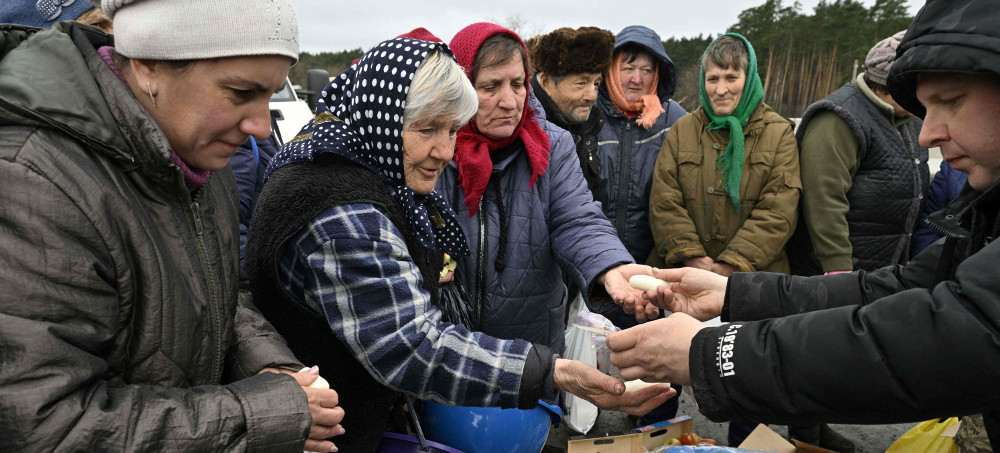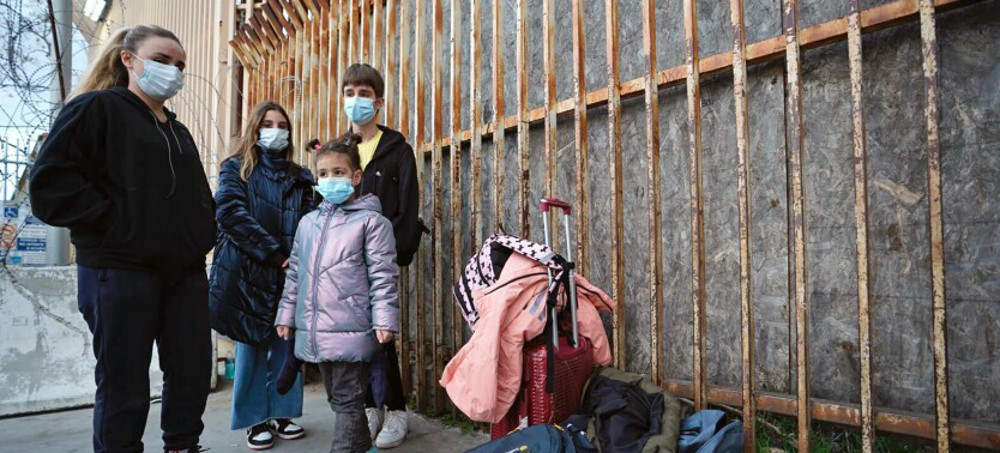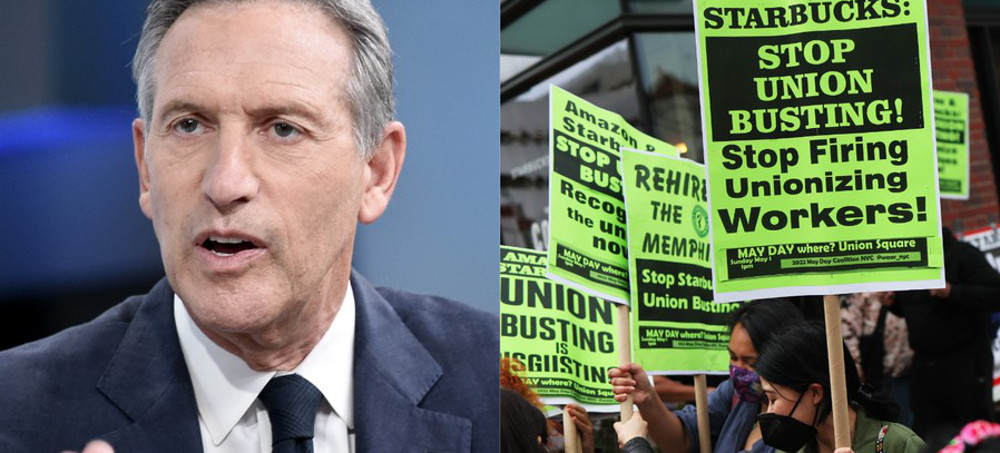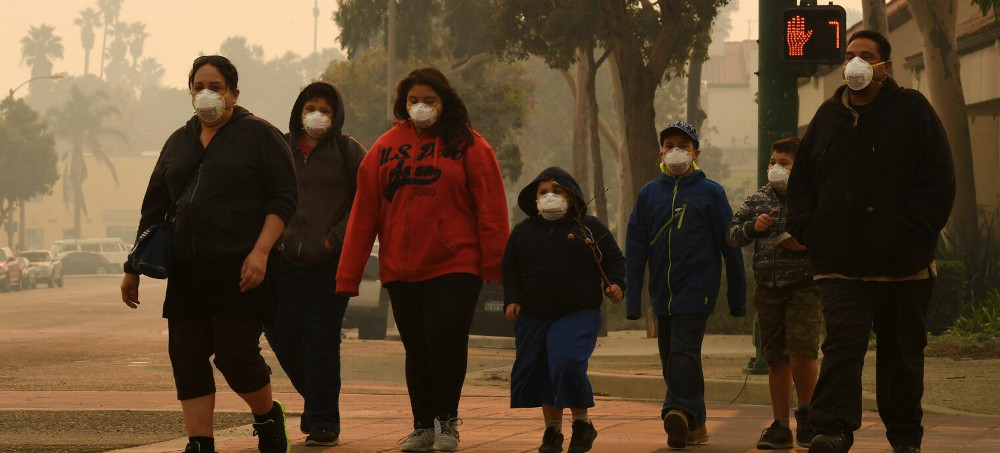Live on the homepage now!
Reader Supported News
 Volunteer distribute food to local residents in the village of Zalissya, northeast of Kyiv, Ukraine. (photo: AFP)
Volunteer distribute food to local residents in the village of Zalissya, northeast of Kyiv, Ukraine. (photo: AFP)
 A Ukrainian family stands by the pedestrian entrance at the San Ysidro Port of Entry on Wednesday after U.S. officials turned the four away. (photo: Alejandro Tamayo/San Diego Union-Tribune)
A Ukrainian family stands by the pedestrian entrance at the San Ysidro Port of Entry on Wednesday after U.S. officials turned the four away. (photo: Alejandro Tamayo/San Diego Union-Tribune)
 This Jan. 15, 2020, still image from dashboard camera video released by the Connecticut State Police shows Trooper Brian North after discharging his weapon and fatally shooting Mubarak Soulemane following a high-speed chase. (photo: AP)
This Jan. 15, 2020, still image from dashboard camera video released by the Connecticut State Police shows Trooper Brian North after discharging his weapon and fatally shooting Mubarak Soulemane following a high-speed chase. (photo: AP)
 Howard Schultz visits Fox & Friends (left) and people hold signs while protesting in front of Starbucks on April 14, 2022 in New York City (right). (photo: Michael M. Santiago/Getty)
Howard Schultz visits Fox & Friends (left) and people hold signs while protesting in front of Starbucks on April 14, 2022 in New York City (right). (photo: Michael M. Santiago/Getty)
 A family wears face masks as they walk through the smoke filled streets after the Thomas wildfire swept through Ventura, California on Dec. 6, 2017. (photo: Mark Ralston/Getty)
A family wears face masks as they walk through the smoke filled streets after the Thomas wildfire swept through Ventura, California on Dec. 6, 2017. (photo: Mark Ralston/Getty)
The American Lung Association annual survey found distressing trends due to climate change and, particularly, increases in fine soot pollution linked to wildfires across the West.
On Thursday, the American Lung Association released its latest annual “State of the Air” report, which evaluates county-level air quality data across the nation over three-year periods. This year’s report—which looked at 2018, 2019 and 2020—found that 137 million Americans were exposed to unhealthy levels of air pollution. That’s 2.1 million more people than recorded in the association’s report last year, and nearly 9 million more when looking specifically at exposure to fine soot pollution, or PM2.5. Those increases were driven largely by a surge in wildfires across the West, the study’s authors said.
The study also found that despite overall decreases in ground-level ozone pollution, which consists of nitrogen oxides and volatile organic compounds, people of color not only continue to face disproportionate exposure to unhealthy air and the associated health impacts, but that those disparities have actually grown slightly.
Counties were graded by the levels of exposure to ozone pollution and both daily and annual exposure to PM2.5—all of which have been linked to increased health risks, including greater risk of asthma attacks, cardiovascular and lung diseases and even premature death. In the United States, for example, PM2.5 is linked to more than 50,000 premature deaths every year, according to recent research.
People of color were nearly two-thirds more likely than white people to live in a county with a failing grade for at least one pollution measure, and 3.6 times as likely to live in a county with a failing grade for all three pollution measures, the study found. That’s up from about 3 times as likely, recorded in last year’s report, nearly a 20 percent increase.
“A consistent theme we find is that the disparities remain, and, I think we show this, are being exacerbated,” said Paul Billings, senior vice president for advocacy at the American Lung Association. “We know that we can’t achieve our vision of a world free of lung disease and reduce the health burden of lung disease unless we address the systemic racism and the burden that imposes on people of color.”
The study adds to a growing body of evidence that has long suggested that people of color and low-income households are not only disproportionately harmed by industrial pollution, but are also first and foremost experiencing the consequences of climate change. It’s also the latest example of the climate crisis worsening inequality, a trend researchers warn could continue if more deliberate action isn’t taken to slow warming and mitigate its consequences.
The Biden administration is currently reviewing national standards both for PM2.5 and for ground-level ozone pollution, commonly referred to as smog.
The Environmental Protection Agency is expected to draft a proposal for new standards under the National Ambient Air Quality Standards, which regulates PM2.5, by this summer, with a final rule expected to go into effect sometime next spring.
“The Lung Association has long called for the strengthening of both those standards,” Billings said. “That’s really our call to action in this year’s report, to support a significant strengthening of PM National Ambient Air Quality Standards.”
A Push for Rapid Electrification
Environmental and health advocates, including the American Lung Association, are also pushing for a rapid electrification of the transportation and power generation sectors as a way to mitigate air pollution and reduce the nation’s health inequalities.
A separate Lung Association report, published last month, found that a widespread, rapid shift to zero-emission transportation and electricity generation could yield tremendous financial benefits by reducing the cost to public health from air pollution and climate impacts by trillions of dollars over the coming decades. By ensuring all passenger vehicles sales are electric by 2035 and all medium- and heavy-duty trucks by 2040, coupled with a full transition of the country’s power plants to renewable energy sources, the United States could prevent 110,000 premature deaths and avoid $1.2 trillion in health-related costs and $1.7 trillion in climate-related costs by midcentury, the study said.
That study also found that communities of color would benefit the most from such a transition. The U.S. counties with the highest percentage of people of color could experience 40 percent of the health benefits—translating to $487 billion in avoided costs through 2050—despite being just 16 percent of the total counties analyzed, the report said.
Several states, led by California, have already implemented rules that would expedite the sales of electric vehicles by ensuring auto sellers carry an increasing stock of EVs in their stores by certain dates. One rule, known as the Advanced Clean Truck rule, has been adopted by six states so far and is expected to have an outsized benefit on communities of color, which are often located near highways and other major transit corridors.
Last summer, President Biden also announced a new goal of getting 50 percent of the vehicles sold in the United States to be zero-emissions by 2030. With the Build Back Better Act effectively dead, however, it’s unclear how the president will achieve that goal without the billions of dollars in electric vehicle tax incentives that were included in that legislation.
Health experts and environmental justice advocates also say that focusing on new vehicle sales isn’t enough and that more should be done to replace the nation’s existing fleet of cars, trucks and buses with both electric versions, as well as newer models with cleaner emissions.
Older diesel trucks, for example, make up a small fraction of the nation’s total truck fleet but contribute to the majority of the harmful air pollution, research has shown.
A study published last week by the TRUE Initiative, a coalition of clean energy advocacy groups, found that diesel trucks manufactured before 2007 make up just 6 to 10 percent of the total truck fleet that operates in New York City but are responsible for up to 83 percent of the fleet’s PM2.5 emissions. People of color living in New York City are also exposed to 17 percent more PM2.5 from diesel vehicles than non-Latino white residents, the study found. Similar conclusions have been produced in nationwide studies as well.
One thing that would help would be assisting smaller trucking companies in replacing their older models sooner, said Dan Greenbaum, president of the Health Effects Institute, a Boston-based research lab.
“A lot of the big trucking companies that truck across the country have already upgraded their fleet; they have cleaner trucks operating,” Greenbaum said. “But a lot of the mom and pop delivery groups, they’re not going to do that. And those are the ones who are in and out of cities, in and out of disadvantaged neighborhoods.”
Recognizing the Legacy of Systemic Racism
Environmental justice advocates have long blamed America’s history of racist laws and practices, such as redlining, for the myriad socioeconomic and health disparities that exist in the United States today. But many prominent scientific institutions, such as the American Lung Association, have failed to publicly recognize that until recently, activists say.
For decades, research has shown that low-income neighborhoods with higher percentages of people of color are far more likely than mostly white and affluent neighborhoods to be located next to industrial pollution and waste management sites, which led to increased risk of cancer, lung disease and other health conditions.
“Much of this inequity can be traced to the long history of systemic racism in the United States,” the American Lung Association wrote in its latest “State of the Air” report.
“Practices such as redlining, the discriminatory outlining of riskier neighborhoods by mortgage lenders, institutionalized residential segregation in the 20th century, impairing the ability of many people of color to build wealth and limiting their mobility and political power,” the institution added. “Over the years, decision-makers have found it easier to place sources of pollution, such as power plants, industrial facilities, landfills and highways, in economically disadvantaged communities of color than in more affluent, predominantly white neighborhoods.”
That language stuck out to Juan Declet-Barreto, a senior social scientist for climate vulnerability with the Union of Concerned Scientists and a former air quality official for the Arizona Department of Environmental Quality.
“There are these very clear indicators of the effect of racist and discriminatory policies in terms of land use, in terms of systemic racism, that show up very clearly in data,” Declet-Barreto said. “And the ALA report is recognizing the legacy of that. I think that’s incredibly important. I don’t think I can overstate the importance of that.”
Greenbaum agreed, saying the Lung Association’s reputation for sound science helps convey the gravity of environmental injustice regarding industrial pollution and air quality regulation.
Billings said the association has made a concerted effort over the last three years to update its policies to better reflect the reality systemic racism has played in the country’s health inequalities. “We have tried to be more explicit, more clear,” he said. “And hopefully, that will then reinforce the urgent need for change, but also work to close the gap.”
Special Coverage: Ukraine, A Historic Resistance
READ MORE
Follow us on facebook and twitter!
PO Box 2043 / Citrus Heights, CA 95611



No comments:
Post a Comment
Note: Only a member of this blog may post a comment.